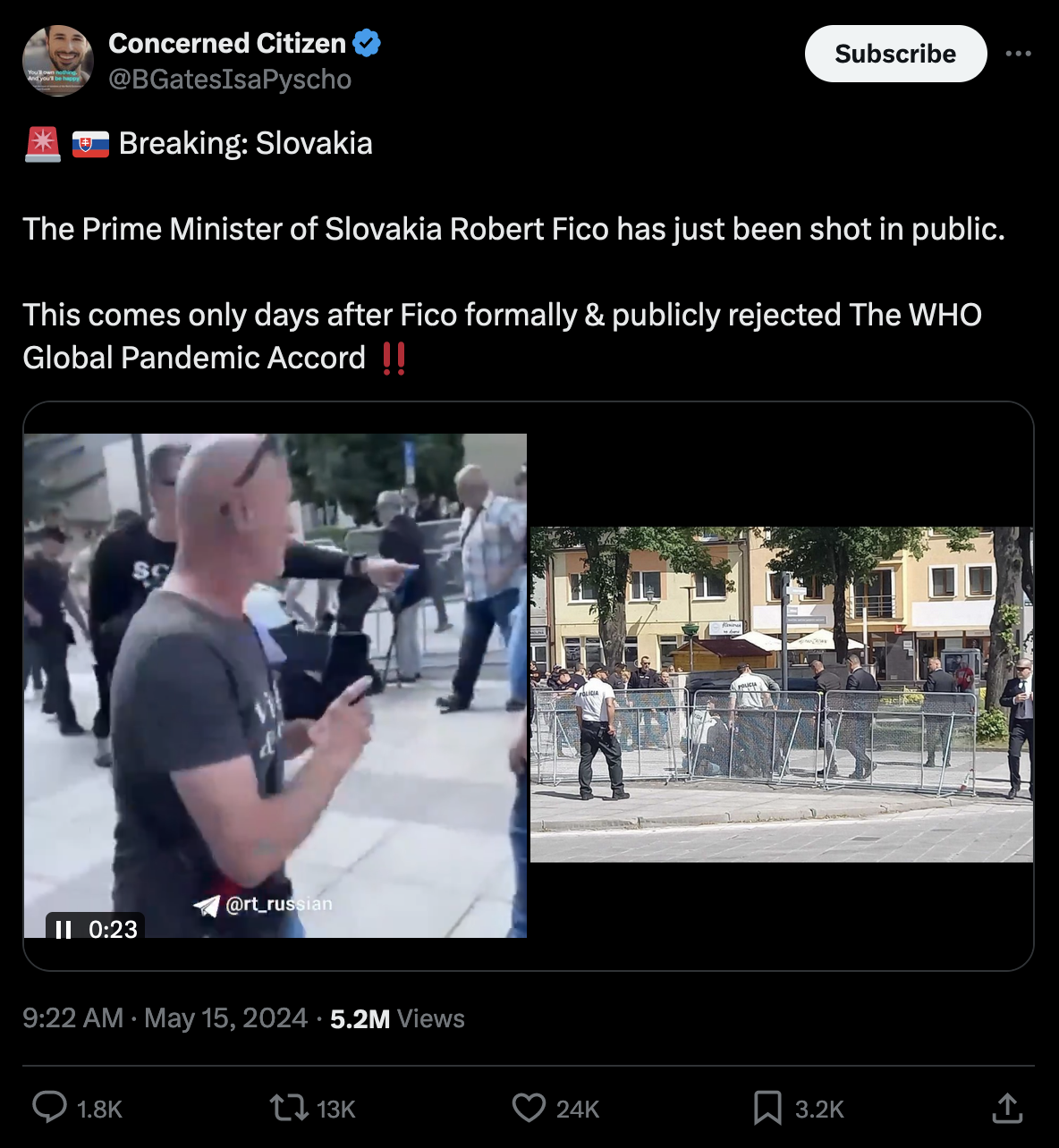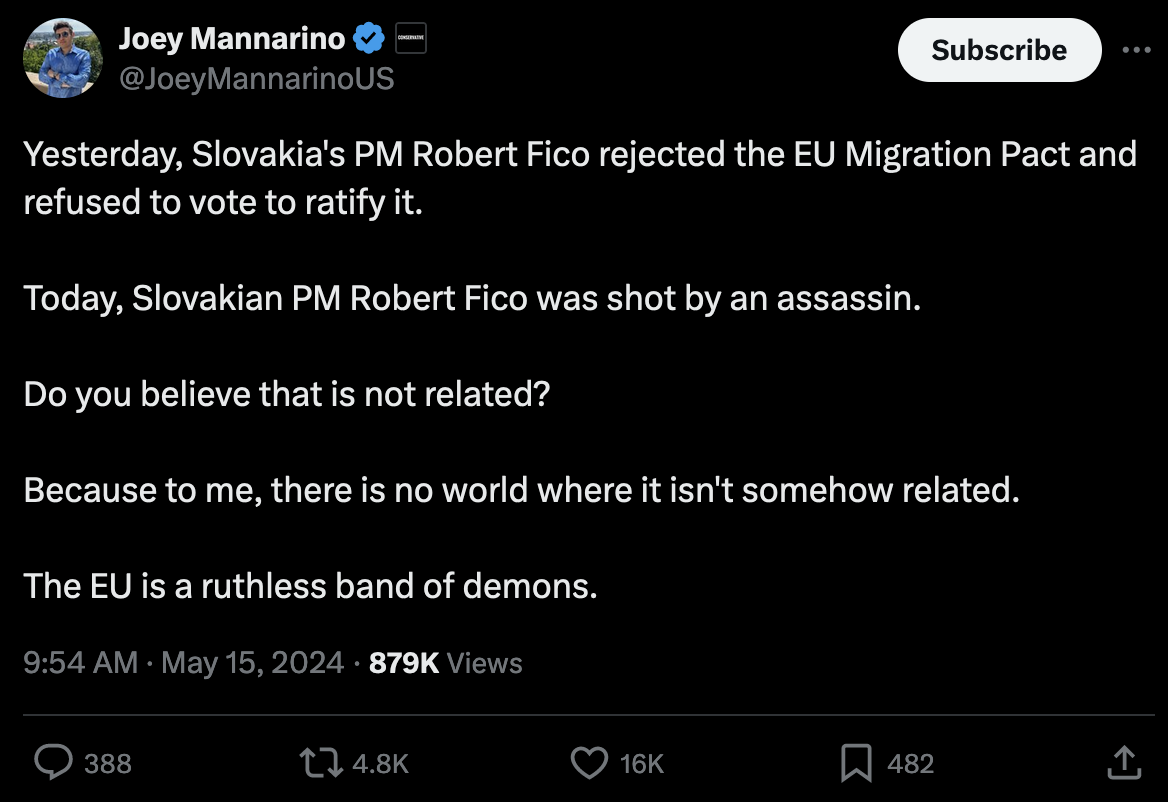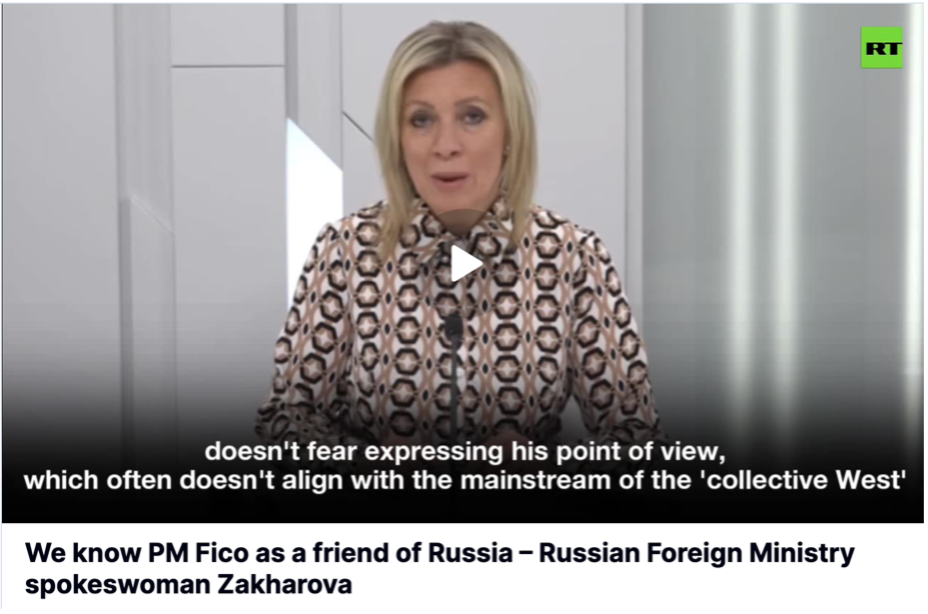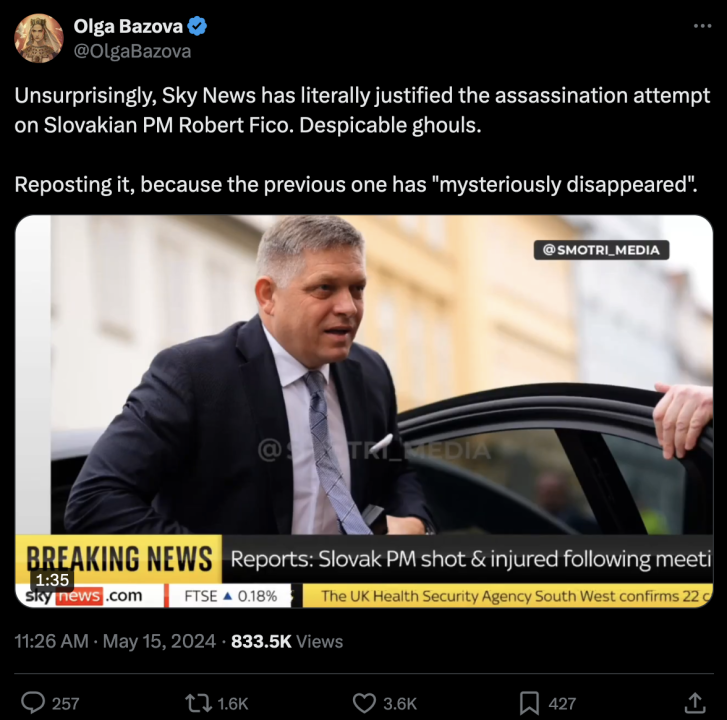Online conspiracies proliferate following the attack on Slovakian PM Robert Fico
Anti-Western and anti-Ukraine narratives circulated online after the assassination attempt on the Slovakian prime minister.
Online conspiracies proliferate following the attack on Slovakian PM Robert Fico

BANNER: A person is detained after Slovakia’s Prime Minister Robert Fico was shot at close range in an assassination attempt, after a government meeting in Handlova, Slovakia, May 15, 2024. Source: REUTERS/Radovan Stoklasa/File Photo)
On May 15, 2024, a gunman shot Slovakia Prime Minister Robert Fico, numerous times, seriously wounding him just after he addressed residents in the Slovakian town of Handlová. Police captured the gunman, identified by local media as a 71-year-old Slovak man, as Fico was rushed to a nearby hospital, where he underwent a series of extensive operations. As the attempted assassination took place in public, eyewitness video footage documented the shooting, as well as the suspect’s capture.
The assassination attempt captured global headlines and rattled Slovakia and the European Union. Fears that a new era of political violence may be coming are shared by politicians and civil society representatives, particularly in Slovakia, given the toxic political situation in the country. Fico himself stepped down as prime minister in 2018 following mass demonstrations after the murder of investigative journalist Ján Kuciak and his girlfriend. Kuciak was reportedly working on a story linking the Slovak government to mafia deals.
Fico has a strong ideological presence in Central and Eastern Europe. His Eurosceptic statements, strict stance on migration, and pro-Russian sentiment on the war in Ukraine have inspired far-right circles in the EU, not unlike Viktor Orban in Hungary.
Fico’s position against COVID restrictions are also popular on the far right. Not surprisingly, one of the first narratives to emerge after his assassination attempt blamed the World Health Organization. With more than 5.2 million views, 13,000 retweets, and 1,800 comments at the time of publishing, one of the first trending X posts about the shooting emphasized Fico’s purported staunch opposition to a supposed “WHO global pandemic agreement.”

Over 800,000 people have also viewed another viral X post from far-right US political commentator Joey Mannarino that linked the assault to Fico’s rejection of the EU Migration Pact.

One of the main narratives claimed that the attack was inspired by Fico’s pro-Russia and anti-West stance around Russia’s war against Ukraine. According to this narrative, the Slovak leader was punished by the West for holding a firm stance in favor of Russia. Maria Zakharova, spokesperson for the Russian Ministry of Foreign Affairs, pushed the point that Fico is Russia’s friend.

On Telegram, Russian writer and paramilitary leader Zakhar Prilepin highlighted Fico’s anti-EU policies and his opposition to providing arms to Ukraine. The post received over 110,000 views.
Vladimir Putin’s response, in which he referred to Fico as “a courageous and strong-minded man,” mirrored that of Prilepin. Also on Telegram, RT head Margarita Simonyan linked the attack on Fico with Ukraine.

As highlighted by Ukraine’s Center for Countering Disinformation, Russian propagandists are exploiting the attempted assassination of Fico to fuel narratives targeting Ukraine and Slovakia and widen differences between European countries. Russia appears to be attempting to further shatter the cohesiveness of the European Union with this campaign.
Russian users on X, Telegram, and VKontakte presented a Sky News interview with British defense analyst Michael Clarke as evidence of the channel allegedly justifying the assassination attempt.

Russian state-sponsored newspaper Argumenty i Fakty (AiF, “Arguments and Facts”) went further, suggesting that the attack could have been organized by the United Kingdom. AiF is one of the most popular weekly newspapers and is owned by the Moscow city government. Echoing that narrative, Sanja Vulich, a member of the Parliamentary Assembly of Bosnia and Herzegovina, said that “Anglo-Saxons are behind the assassination attempt on Slovak Prime Minister Robert Fico,” as she told Rossiyskaya Gazeta.
Scott Bennett, a former US Army psychological operations officer and frequent Sputnik contributor, suggested without evidence that the assassination attempt may be a part of a NATO operation targeting leaders opposing support for Ukraine. Bennett drew parallels between this incident and the assassination of US President John F. Kennedy in 1963.
Meanwhile, the Czech publication Nová republika reposted a story, originally published by Slovak outlet “Armadny Magazin,” in which the author conspiratorially hinted that NATO was behind the attack. The two publications quoted Russian pro-Kremlin figure Armen Gasparyan, who started spreading the idea that Fico was a victim of EU and NATO through propaganda sources, including Sputnik, RT, and Life.ru.
Leading Slovak nationalist and far-right MP Andrej Danko accused the “dirty media” of preparing the grounds for the assassination attempt by publishing unfair coverage. Hungarian state media replicated the attacks, accusing the opposition media and their audience of hoping that the same would happen to Viktor. Far-right figure Bence Apáti wrote on his social media, “Congratulations 444, Telex, this is your work.” 444 and Telex are liberal media outlets in Hungary, placing them in opposition to the ruling far-right Fidesz party headed by Orban.
The narratives evolved in Bulgaria too, where media outlets claimed that Fico, like Orban, had paid the price for defending the supposed “national interest” and fighting against “mainstream politicians.” A popular tabloid blamed the attack on “pro-war liberals.” Immediately after the attack, the leader of the pro-Russian Revival party in Bulgaria also amplified the theory that Fico was shot because of his anti-Ukraine stance.
A tweet from right-wing influencer Andrew Tate, who is currently under indictment in Romania, painted a comprehensive anti-system narrative. Tate also used the term “nazi” to describe the COVID-19 pandemic regulations imposed in the Slovakian government prior to Fico’s return to power. The tweet received more than 3.6 million views.
A post to X by Florian Philippot, leader of the French far-right party Les Patriotes (“The Patriots”), described Fico as a “peace fighter” because of his stance against NATO and EU policies and also his willingness “to reveal the truth” about COVID-19 vaccines.
On May 16, Slovak police charged 71-year-old Juraj Cintula with the attempted assassination. RT was among the first broadcasters to showcase a clip of the attack and name the alleged attacker.
Regional and international media outlets discovered evidence on social media that Cintula expressed sympathy for the now-disbanded paramilitary organization Slovenskí Branci (SB, “Slovak Warriors”) in 2016. Slovak media also discovered a book he wrote in which he criticized the state for its excessive generosity in its welfare policies toward the Roma population. Multiple unverified manifestos and recordings of his confession have also widely circulated online.
Cite this case study:
Ruslan Trad, “Online conspiracies proliferate following the attack on Slovakian PM Robert Fico,” Digital Forensic Research Lab (DFRLab), May 22, 2024, https://dfrlab.org/2024/05/22/online-conspiracies-proliferate-following-the-attack-on-slovakian-pm-robert-fico/.

